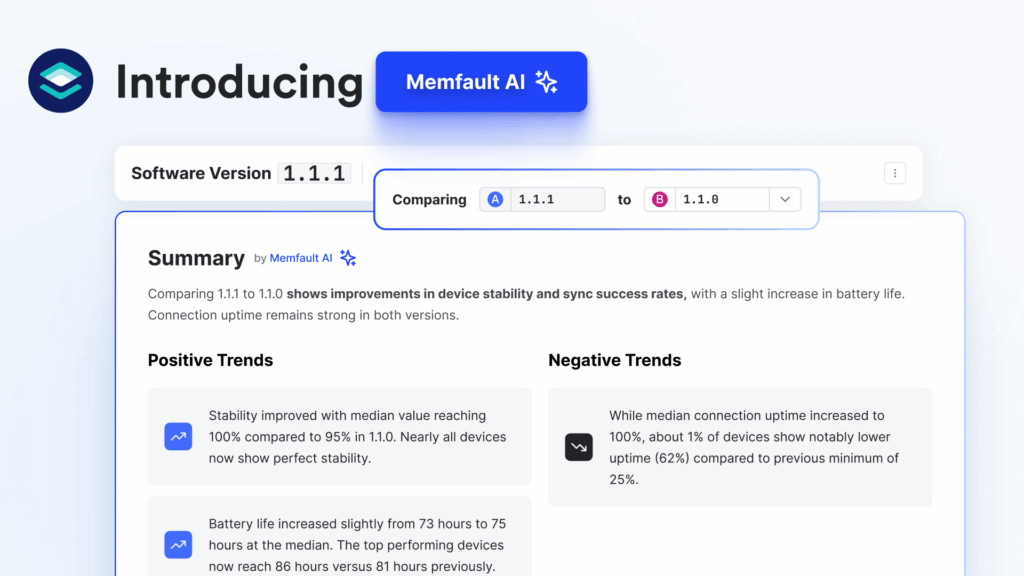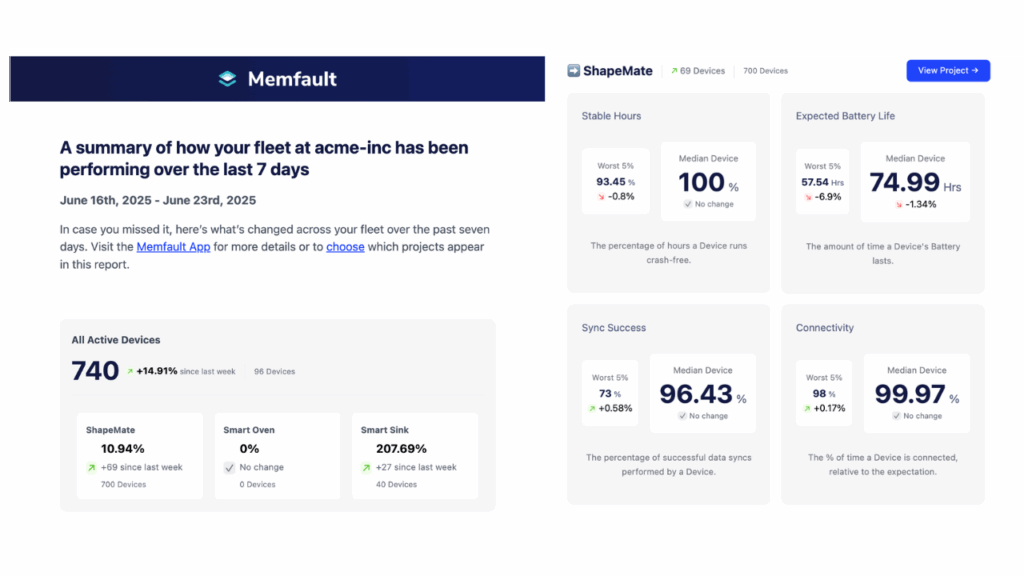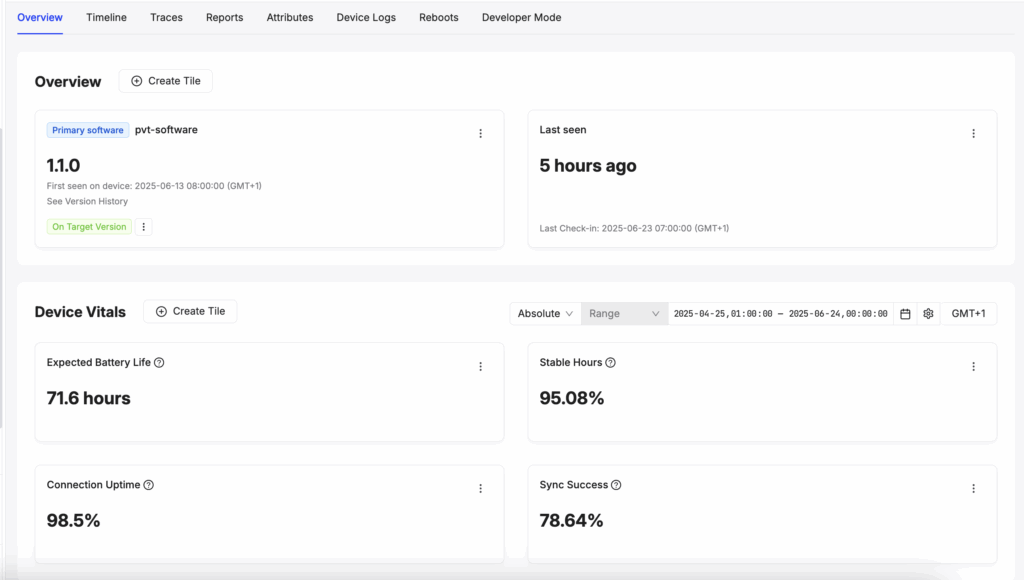Share
Memfault helps teams that care about building great connected devices improve product quality and launch faster with more confidence. Whether you’re a Firmware Engineer trying to debug a complex memory leak in field testing or a Product Manager trying to understand if battery life is holding up after a new feature release, Memfault is built for you.
Building hardware is hard, and we want Memfault to play a part in making your life easier. We also believe that the data we collect in Memfault has the ability to empower your entire business to make better decisions about the development of your devices. And as a result, we have been making a number of improvements focused on turning great data into great insights that are easily accessible.
This update will share some highlight features we have launched, including adding flash wear monitoring out-of-the-box with a new Device Vital, improving the Device Overview page, adding a new Release Report…
And…
…luckily for us, it’s 2025, and that means the world has access to some “new” and extremely powerful tools to make getting insights from data easier than ever…
Introducing Memfault AI
This will come as no surprise, but we are adding AI to Memfault. However, we are doing this carefully. We know that we collect great data, but we also know our customers care a lot about the privacy of that data, and so the first thing we want to call out is that customers have to opt in if they want access to our AI features.
Initially, Memfault AI is implemented within our new Release Report, providing an AI analysis of improvements and regressions between your latest release and a previous version. Acting as another set of “eyes” to review and compare the performance of your release on critical metrics like Stability and Connectivity, and highlighting how things have changed. In the future, Memfault AI will help users resolve issues faster, easily analyze large data sets, and more.
Memfault AI is available to all Memfault customers on all Plans. It can be enabled by an organization Admin in your settings.
The Release Report
Reviewing releases and deciding whether your latest version is good enough for a production rollout or not is a complicated and stressful task. The new Release Report in Memfault makes this a little easier.
The Release Report automatically includes a number of important data points that will help you assess release performance, including devices on this version, reboot trends, new issues and impact of issues. The Release Report then provides a comparison of this release with an automatically selected reference version against all of those data points.
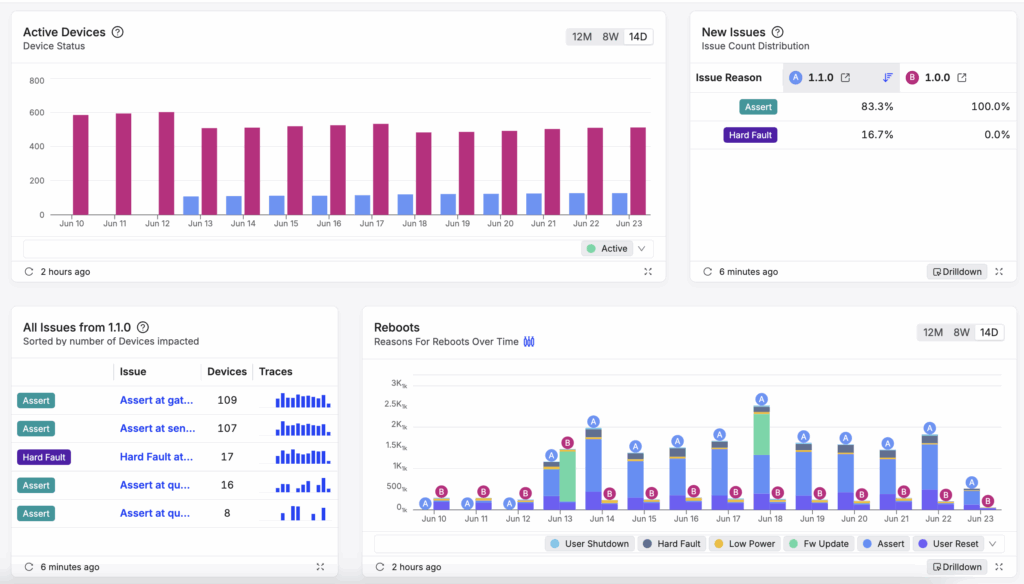
Critical data automatically comparing my new version with the previous version.
As mentioned, the Release Report also contains a summary of positive and negative trends in this version, compared to the reference version, provided by Memfault AI.

Uh oh. This release is not looking good.
As you can see in the example above, Memfault AI has identified a number of concerning regressions on my most recent version in comparison with the previous. The Release Report gathers the critical data you need to assess performance, all in one place, and gives you a smart starting point for identifying performance problems, courtesy of Memfault AI.
A new Device Vital: Flash Wear
Understanding how your Flash is wearing, and the implications it has on the longevity of your device, has been, up until now, shrouded in mystery. Most teams are resorting to best guesses and crossed fingers when it comes to understanding whether the changes they are making are going to cause premature flash failures down the line.
Not anymore.
We are really excited to have added Flash Wear to our Device Vitals data set. A quick refresher on Device Vitals – Device Vitals are what we believe to be the most critical baseline quality and performance measures that all embedded teams should be tracking on devices in the field. In Memfault, Device Vitals are collected out-of-the-box on all our latest SDKs, meaning getting this data is super easy, and all of the data collected can be analyzed in our product with built in charts and dashboard cards.
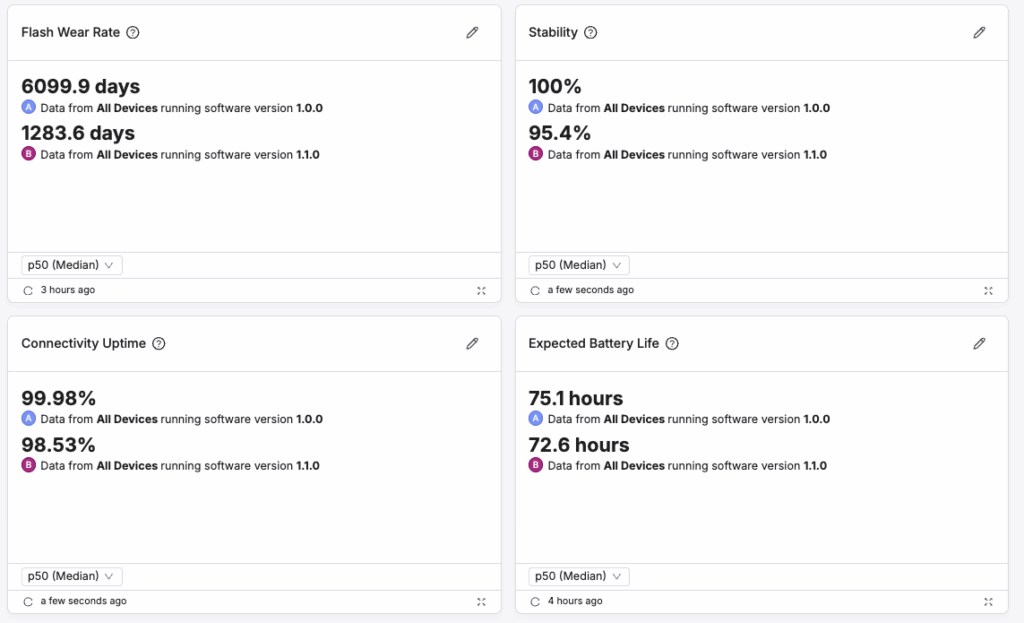
Comparing the performance of two releases based on out-of-the-box Device Vitals measures.
Flash Wear is the latest addition to Device Vitals, alongside our existing Stability, Connectivity, and Battery Life Vitals. Just like the other Vitals it’s now collected out-of-the-box on our Linux, Android and MCU SDKs (although there are some limitations dependent on what type of Flash you are using). There are two key measures:
- Flash Wear Rate – How quickly your flash is wearing out, extrapolated to estimate total possible lifespan of a brand new Flash if wearing at the current rate.
- Flash Life Remaining – A forward-looking estimate of how long the flash will last on a specific device based on current wear patterns.
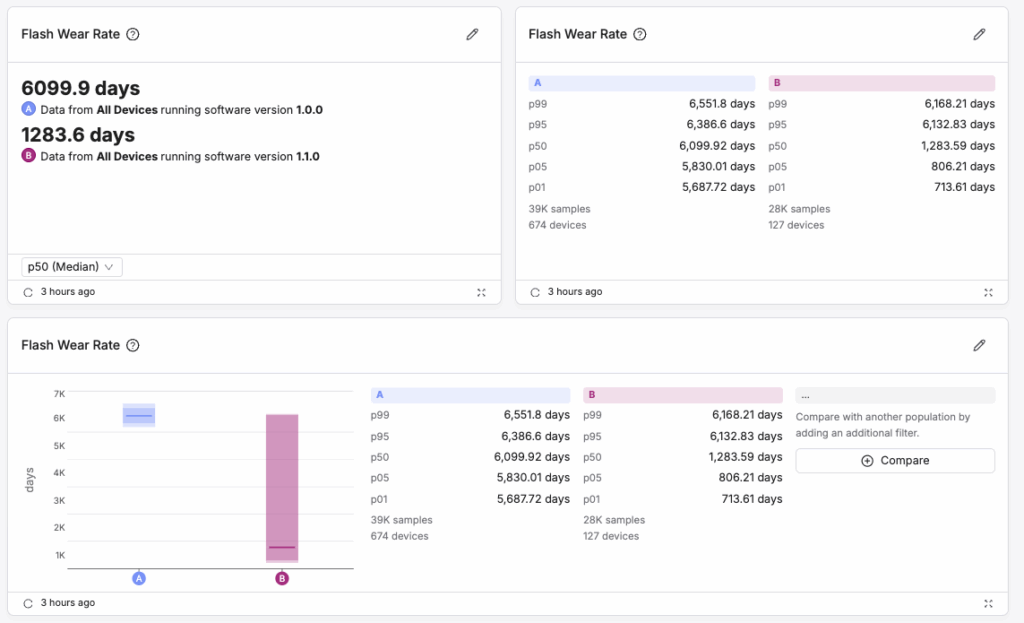
Built-in cards and charts showing Flash Wear rate for the median device and across each percentile.

A breakdown of the fleet based on flash lifetime remaining.
The combination of these two measures will allow Memfault users to predict when a Flash might fail before it happens, and identify when changes you are making are accelerating the rate at which Flash is wearing, so that you can optimize and extend the lifespan of Flash on your devices.
Fleet Health Summary
In support of our ambition to empower your entire business and deliver insights from the data we collect, we have added a weekly fleet health summary email. This email, delivered every 7 days to every user on an account, will highlight changes in your fleet week over week. It highlights changes in your active devices, the top software versions, and how your fleet is performing based on Memfault’s Device Vitals metrics.
This data lands straight in your inbox, every week, and means you don’t have to be constantly jumping in and out of dashboards to feel like you are on top of what’s happening on your devices in the field. It gives your whole team the same level of visibility on the metrics that matter, with no extra effort.
Device Overview Page
And finally, keeping with the theme of more accessible insights we have made some significant improvements to the Device Overview page. Previously, when users clicked on a device from the Device Inventory, they landed on the Device Timeline. Timeline is great, it has tons of useful data, but it is very in-depth and can be a little overwhelming. It’s designed for investigations, and for that purpose, it is powerful, but often users just want a quick status check of the device health.
Now, when users click on a device, they will land on the new Device Overview page. This page contains status information such as software version, last check-in, and if the device is staged for an update. It also now includes Device Vitals information for that individual device.
Users can also customize the information presented in Device Overview so that it makes sense for their specific use case. This makes the Device Overview page a great tool for quick troubleshooting. An end user might be reporting battery issues or instability, and now all you need is the device serial number to confirm the reports with data from that specific device. The Memfault users (perhaps someone in Support) can also limit the data to a specific time range, making point-in-time status information easy to access.
Wrap-Up
The team at Memfault is really excited about the power of this combination of new features. As always we continue to work closely with our customers to bring improvements that will have an impact on their workflows and their business over all. We have had some great examples recently about the power of Memfault to help the Product and Engineering team really transform the performance of the entire business (see our recent case studies with Gabb and reMarkable as examples).
And of course, we couldn’t conclude without a quick note on the acquisition of Memfault by Nordic Semiconductor. Firstly, we want to reiterate that we will continue to support a wide range of platforms, including Linux, Android, and chips from other manufacturers. This acquisition doesn’t change that, in fact, we believe it only accelerates our plans and gives us even more ability to build a great product for everyone. Now, if you are on Nordic, you can expect certain benefits in the future, including an even easier integration process, closer ties with other nRF cloud services, and more.
We look forward to sharing more detail and a host more exciting new features in our next update. If you have any questions about the features in this update, the Nordic acquisition, or anything else, please reach out to the team.
Thanks for joining us on this journey, and we can’t wait to share more about the next exciting chapter for Memfault.
Until next time.
Team Memfault


